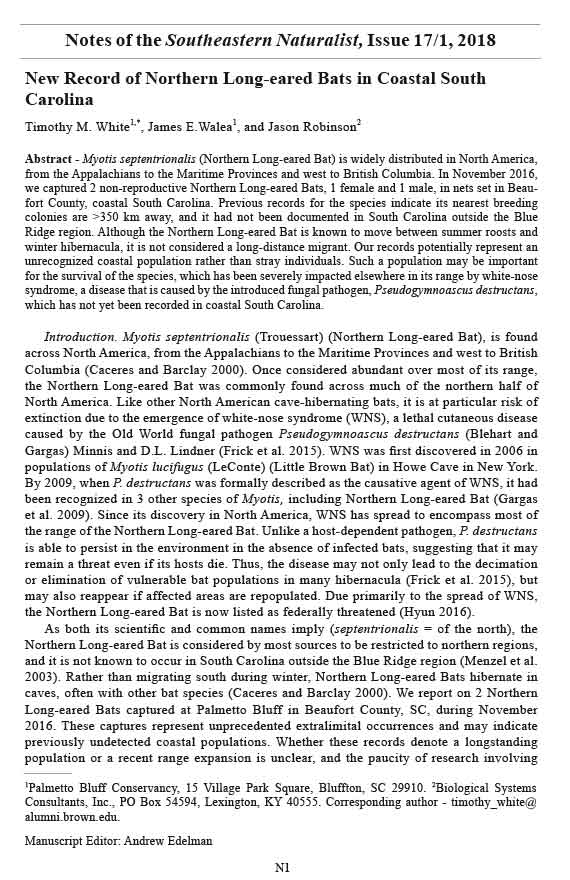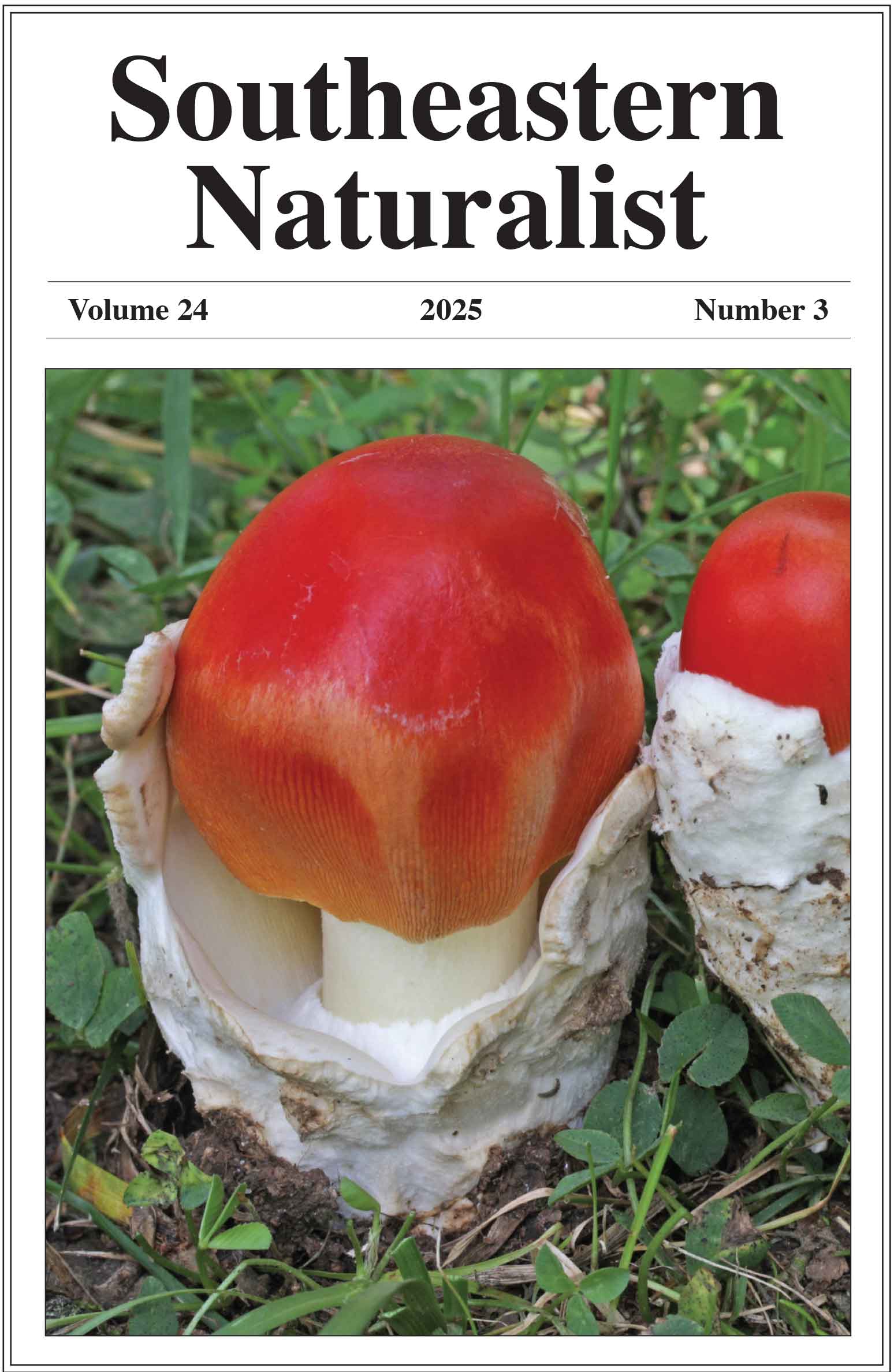N1
2018 Southeastern Naturalist Notes Vol. 17, No. 1
T.M. White, J.E.Walea, and J. Robinson
New Record of Northern Long-eared Bats in Coastal South
Carolina
Timothy M. White1,*, James E.Walea1, and Jason Robinson2
Abstract - Myotis septentrionalis (Northern Long-eared Bat) is widely distributed in North America,
from the Appalachians to the Maritime Provinces and west to British Columbia. In November 2016,
we captured 2 non-reproductive Northern Long-eared Bats, 1 female and 1 male, in nets set in Beaufort
County, coastal South Carolina. Previous records for the species indicate its nearest breeding
colonies are >350 km away, and it had not been documented in South Carolina outside the Blue
Ridge region. Although the Northern Long-eared Bat is known to move between summer roosts and
winter hibernacula, it is not considered a long-distance migrant. Our records potentially represent an
unrecognized coastal population rather than stray individuals. Such a population may be important
for the survival of the species, which has been severely impacted elsewhere in its range by white-nose
syndrome, a disease that is caused by the introduced fungal pathogen, Pseudogymnoascus destructans,
which has not yet been recorded in coastal South Carolina.
Introduction. Myotis septentrionalis (Trouessart) (Northern Long-eared Bat), is found
across North America, from the Appalachians to the Maritime Provinces and west to British
Columbia (Caceres and Barclay 2000). Once considered abundant over most of its range,
the Northern Long-eared Bat was commonly found across much of the northern half of
North America. Like other North American cave-hibernating bats, it is at particular risk of
extinction due to the emergence of white-nose syndrome (WNS), a lethal cutaneous disease
caused by the Old World fungal pathogen Pseudogymnoascus destructans (Blehart and
Gargas) Minnis and D.L. Lindner (Frick et al. 2015). WNS was first discovered in 2006 in
populations of Myotis lucifugus (LeConte) (Little Brown Bat) in Howe Cave in New York.
By 2009, when P. destructans was formally described as the causative agent of WNS, it had
been recognized in 3 other species of Myotis, including Northern Long-eared Bat (Gargas
et al. 2009). Since its discovery in North America, WNS has spread to encompass most of
the range of the Northern Long-eared Bat. Unlike a host-dependent pathogen, P. destructans
is able to persist in the environment in the absence of infected bats, suggesting that it may
remain a threat even if its hosts die. Thus, the disease may not only lead to the decimation
or elimination of vulnerable bat populations in many hibernacula (Frick et al. 2015), but
may also reappear if affected areas are repopulated. Due primarily to the spread of WNS,
the Northern Long-eared Bat is now listed as federally threatened (Hyun 2016).
As both its scientific and common names imply (septentrionalis = of the north), the
Northern Long-eared Bat is considered by most sources to be restricted to northern regions,
and it is not known to occur in South Carolina outside the Blue Ridge region (Menzel et al.
2003). Rather than migrating south during winter, Northern Long-eared Bats hibernate in
caves, often with other bat species (Caceres and Barclay 2000). We report on 2 Northern
Long-eared Bats captured at Palmetto Bluff in Beaufort County, SC, during November
2016. These captures represent unprecedented extralimital occurrences and may indicate
previously undetected coastal populations. Whether these records denote a longstanding
population or a recent range expansion is unclear, and the paucity of research involving
1Palmetto Bluff Conservancy, 15 Village Park Square, Bluffton, SC 29910. 2Biological Systems
Consultants, Inc., PO Box 54594, Lexington, KY 40555. Corresponding author - timothy_white@
alumni.brown.edu.
Manuscript Editor: Andrew Edelman
Notes of the Southeastern Naturalist, Issue 17/1, 2018
2018 Southeastern Naturalist Notes Vol. 17, No. 1
N2
T.M. White, J.E.Walea, and J. Robinson
trapping or acoustic monitoring of bats in the coastal Southeast gives little precedent from
which to draw meaningful inference.
Methods. From May 2016 to March 2017, we conducted mist netting at Palmetto Bluff,
Beaufort County, SC. Palmetto Bluff is an area of maritime and Pinus (pine) forests, a large
part of which is being developed as a residential and resort community. We set nets in undeveloped
areas as well as tracts under conservation easement.
We captured bats with 50-denier, 38-mm–mesh mist-nets measuring 2.6 m high and 6 m,
9 m, 12 m, and 18 m long. We placed nets in likely flyways in areas adjacent to wetlands,
ponds, fields, and forest. We used multi-tier nets in some locations, stacking 2 or 3 of the
2.6-m nets for a total of 5.2 m or 7.8 m height, respectively. We deployed nets for a minimum
of 3 h after sunset on each netting night. Northern Long-eared Bat was an unexpected
find in the area; thus, we collected and sent hair and fecal samples to the Species from Feces
program at the Bat Ecology and Genetics Lab at the School of Forestry, Northern Arizona
University, Flagstaff, AZ. We recorded weight, length measurements, sex, and age, the latter
of which we determined by examining the level of epiphyseal joint fusion. We banded both
bats on the forearm with numbered metal bands before releasing them.
Results. We captured the 2 Northern Long-eared Bats at the same location (32°10'59''N,
80°53'30''W), in the River Road Preserve, a 59-ha tract that is protected by a conservation
easement and owned by the Palmetto Bluff Conservancy, Palmetto Bluff, SC, in November
2016. The site at which we captured both bats is a mixed pine–hardwood ecosystem
immediately adjacent to tidal saltmarsh and within 250 m of an artificial freshwater pond.
Forest composition is characteristic of regenerating maritime forest in the coastal Southeast,
dominated by Quercus virginiana Mill. (Southern Live Oak), Sabal palmetto (Walter) Lodd.
Ex Schult.&Schult.f. (Cabbage Palmetto), and Pinus taeda L. (Loblolly Pine), with an open
understory that contained scattered stands of Serenoa repens (W. Bartram) Small (Saw
Palmetto). We captured the bats on 3 and 14 November 2016. We present the data collected
for each bat in Table 1. The identification of the first specimen as a Northern Long-eared
Bat was confirmed by Sanger DNA sequencing (F. Walker, Bat Ecology and Genetics Lab,
Northern Arizona University, Flagstaff, AZ). We were unable to genetically confirm species
identification of the second bat from fur and fecal samples because of small sample-volume;
however, in light of the DNA-confirmed identification of the first individual, it is unlikely
that we misidentified the second bat.
Discussion. Menzel et al. (2003) reported 7 museum specimens and 69 capture records of
Northern Long-eared Bats in South Carolina, all from the Blue Ridge region of the southern
Appalachians, an area where WNS is endemic. Scattered records from the North Carolina
Coastal Plain (Morris et al. 2009) and from central Louisiana (Crnkovic 2003) were unexpected
occurrences, although in both cases the number of individuals and the reproductive
status suggested the potential presence of breeding colonies. Although an abnormal weather
Table 1. Capture and measurement data from 2 Northern Long-eared Bats caught at Palmetto Bluff, SC.
Bat 1 Bat 2
Date of capture 3 Nov 2016 14 Nov 2016
Time after sunset 75 min 50 min
Sex Female Male
Age Adult First-year adult
Weight 7.5 g 6 g
Forearm length 39 mm 34 mm
Reproductive status Non-reproductive Non-reproductive
N3
2018 Southeastern Naturalist Notes Vol. 17, No. 1
T.M. White, J.E.Walea, and J. Robinson
event from the north or west could be responsible for driving small numbers of bats far from
their normal range, there were no such events in the weeks preceding our captures. A map
showing the locations of previous records and known hibernacula is provided in Figure 1.
Northern Long-eared Bat hibernacula are typically located in caves or mines (Menzel
et al. 2003), which are non-existent in the coastal plains of South Carolina and Georgia
(Culver et al. 1999). The nearest geological formations to our site that might contain cavelike
hibernacula are limestone sinks near Santee, ~140 km to the north (Malde 1959) and
scattered limestone outcroppings on the upper Savannah River, more than 150 km to the
northwest (Cooke 1936). Both of these locations are outside the typical seasonal ranges of
Northern Long-eared Bats (Caceres and Barclay 2000). Thus, it seems likely that either the
bats were hibernating in human-made sites—a behavior that has been occasionally documented
(Menzel et al. 2003)—or are surviving the winter by roosting in trees rather than
hibernating in caves. Either situation would represent a notable divergence from previously
identified typical winter behaviors. Whether our findings represent overlooked breeding
colonies or recent range expansions is unclear; however, Barbour and Davis (1969) characterized
Northern Long-eared Bats as a non-migratory or only locally migratory species,
indicating that long-distance strays are unlikely. Arnold (2007) tentatively concluded that
Figure 1. Counties in gray represent documented records of Northern Long-eared Bats (Myotis septentrionalis)
in Georgia (GA), South Carolina (SC), and North Carolina(NC) (GADNR 2017, Menzel et
al. 2003, NCDPR 2017, USFWS 2017). Counties marked with a black dot contain known hibernacula
(J. Kindel, South Carolina Department of Natural Resources, Union, SC, unpubl. data; K. Caldwell,
North Carolina Wildlife Resources Commission, Asheville, NC, unpubl. data; K. Morris, Georgia
Department of Natural Resources, Atlanta, GA, unpubl. data). Beaufort County, where 2 Northern
Long-eared Bats in this study were captured, is marked in darker gray.
2018 Southeastern Naturalist Notes Vol. 17, No. 1
N4
T.M. White, J.E.Walea, and J. Robinson
Northern Long-eared Bats display high breeding-site fidelity, suggesting that reproducing
coastal populations may persist in subsequent seasons.
P. destructans is an obligate psychrophilic pathogen; thus, it infects only hibernating
bats whose body temperature is reduced to below 20 °C during torpor (Frick et al. 2015).
Although no populations of Northern Long-eared Bats have yet been reported to survive
winters without hibernating, Weller et al. (2009), suggested that bats may have the behavioral
fluidity to change their hibernation habits to compensate for rising temperatures. Additionally,
Grider et al. (2016) report that bat-foraging activity continued year-round in the
coastal plain of North Carolina, and that Northern Long-eared Bats were among those active
in the winter months. The area around the capture site averages a nightly minimum of 4 °C
in January (NESDIS 2017), which is significantly higher than the mean nightly minimum
of 1.5 °C reported by Grider et al. (2016), in North Carolina. These warmer temperatures
may lead to higher levels of insect activity. Although we cannot rule out the possibility
that the bats we captured do hibernate, the lack of suitable natural hibernation sites and the
warm winter temperatures suggest that they may be active year-round. The discovery of
non-hibernating populations of Northern Long-eared Bats would be particularly important
from a conservation standpoint because they may be less susceptible to WNS, which is
most virulent during low-temperature torpor. As of 2015, WNS has not been detected in the
coastal plain of North Carolina or South Carolina (Frick et al. 2015), and Northern Longeared
Bats in these regions may present a rare opportunity to protect uninfected populations
of the species.
Acknowledgments. We thank Mary Bunch, Katherine Caldwell, Jennifer Kindel, Susan Loeb, Katrina
Morris, Mary Socci, Justin Hardy, Shane Rahn, Brittany Hall, Tom Wilson, and Sam Freeze for
their assistance. We extend special appreciation to Dallas Wood and Crescent Communities for their
support of research and conservation at Palmetto Bluff. Funding for the project was provided by the
US Fish and Wildlife Service’s State Wildlife Grant Program through the South Carolina Department
of Natural Resources. Matching funds were provided by the Palmetto Bluff Conservancy.
Literature Cited
Arnold, B.D. 2007. Population structure and sex-biased dispersal in the forest-dwelling vespertilionid
bat Myotis septentrionalis. American Midland Naturalist 157(2):374–384.
Barbour, R.W., and W.H. Davis. 1969. Bats of America. The University of Kentucky Press, Lexington,
KY. 286 pp.
Caceres, M.C., and R.M.R. Barclay. 2000. Myotis septentrionalis. Mammalian Species 634:1–4.
Cooke, C.W. 1936. Geology of the Coastal Plain of South Carolina. US Government Printing Office,
Washington, DC. 218 pp.
Crnkovic, A.C. 2003. Discovery of Northern Long-eared Myotis, Myotis septentrionalis (Chiroptera:
Vespertilionidae), in Louisiana. Southwestern Naturalist 48(4):715–717.
Culver, D.C., H.H. Hobbs III, M.C. Christman, and L.L. Master. 1999. Distribution map of caves and
cave animals in the United States. Journal of Cave and Karst Studies 61(3):139–140.
Frick, W.F., S.J. Puechmaille, and C.K.R. Willis. 2015. White-nose syndrome in bats. Pp. 245–262,
In C. Voigt and T. Kingston (Eds). Bats in the Anthropocene: Conservation of Bats in a Changing
World. Springer International Publishing, Cham, Switzerland. 606 pp.
Gargas, A., M.T. Trest, M. Christensen, T.J. Volk, and D.S. Blehert. 2009. Geomyces destructans sp.
nov. associated with bat white-nose syndrome. Mycotaxon 108:147–154.
Georgia Department of Natural Resources (GADNR). 2017. Georgia rare natural elements data
portal. Myotis septentrionalis. Available online at http://gakrakow.github.io/natels/range_maps2.
html?es_id=17848. Accessed 9 October 2017.
Grider, J.F., A.L. Larsen, J.A. Homyack, and M.C. Kalcounis-Rueppell. 2016. Winter activity of
coastal plain populations of bat species affected by white-nose syndrome and wind energy facilities.
PLoS ONE 11:1–14.
N5
2018 Southeastern Naturalist Notes Vol. 17, No. 1
T.M. White, J.E.Walea, and J. Robinson
Hyun, K.H. 2016. Endangered and threatened wildlife and plants; 4(d) rule for the Northern
Long-eared Bat. US Fish and Wildlife Service, Department of the Interior. Federal Register
81(9):1900–1922.
Malde, H.E. 1959. Geology of the Charleston Phosphate Area. US Government Printing Office,
Washington, DC. 118 pp.
Menzel, J.M., M.A. Menzel, W.M. Ford, J.W. Edwards, S.R. Sheffield, J.C. Kilgo, and M.S. Bunch.
2003. The distribution of the bats of South Carolina. Southeastern Naturalist 2(1):121–152.
Morris, A.D., M.J. Vonhof, D.A. Miller, and M.C. Kalcounis-Rueppell. 2009. Myotis septentrionalis
Trouessart (Northern Long-eared Bat) records from the coastal plain of North Carolina. Southeastern
Naturalist 8(2):355–362.
National Environmental Satellite, Data, and Information Service (NESDIS). 2017. Summary of
monthly normals 1981–2010. Available online at https://www.nesdis.noaa.gov/. Accessed 4 October
2017.
North Carolina Department of Parks and Recreation (NCDPR). 2017. Mammals of North Carolina.
Available online at http://www.dpr.ncparks.gov/mammals/view.php?id=28. Accessed 9 October
2017.
US Fish and Wildlife Service (USFWS). 2017. Raleigh Ecological Services Field Office. Online
Project Reviews: The Northern Long-eared Bat. Available online at https://www.fws.gov/raleigh/
NLEB_RFO.html. Accessed 9 October 2017.
Weller, T.J., P.M. Cryan, and T.J. O’Shea. 2009. Broadening the focus of bat conservation and research
in the USA for the 21st century. Endangered Species Research 8(1–2):129–145.














 The Southeastern Naturalist is a peer-reviewed journal that covers all aspects of natural history within the southeastern United States. We welcome research articles, summary review papers, and observational notes.
The Southeastern Naturalist is a peer-reviewed journal that covers all aspects of natural history within the southeastern United States. We welcome research articles, summary review papers, and observational notes.